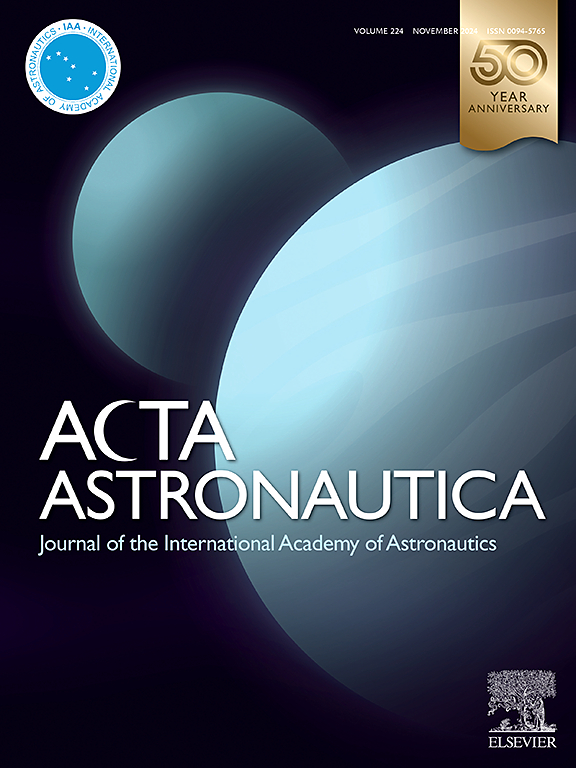Secular dynamics and the lifetimes of lunar artificial satellites under natural force-driven orbital evolution
IF 3.1
2区 物理与天体物理
Q1 ENGINEERING, AEROSPACE
引用次数: 0
Abstract
In this paper, we study the long-term (time scale of several years) orbital evolution of lunar satellites under the sole action of natural forces. In particular, we focus on secular resonances, caused either by the influence of the multipole moments of the lunar potential and/or by the Earth’s and Sun’s third-body effect on the satellite’s long-term orbital evolution. Our study is based on a simplified secular model obtained in ‘closed form’, i.e., without expansions in the satellite’s orbital eccentricity. Contrary to the case of artificial Earth satellites, in which many secular resonances compete in dynamical impact, we give numerical evidence that for lunar satellites only the resonance () affects significantly the orbits at secular timescales. We interpret this as a consequence of the strong effect of lunar mascons. We show that the lifetime of lunar satellites is, in particular, nearly exclusively dictated by the resonance. By deriving a simple analytic model, we propose a theoretical framework which allows for both qualitative and quantitative interpretation of the structures seen in numerically obtained lifetime maps. This involves explaining the main mechanisms driving eccentricity growth in the orbits of lunar satellites. In fact, we argue that the re-entry process for lunar satellites is not necessarily a chaotic process (as is the case for Earth satellites), but rather due to a sequence of bifurcations leading to a dramatic variation in the structure of the separatrices in the resonance’s phase portrait, as we move from the lowest to the highest limit in inclination (at each altitude) where the resonance is manifested.
自然力驱动轨道演变下的月球人造卫星的周期动态和寿命
在本文中,我们研究了月球卫星在自然力单独作用下的长期(数年时间尺度)轨道演变。我们尤其关注月球势能多极矩的影响和/或地球和太阳对卫星长期轨道演变的第三体效应所引起的世俗共振。我们的研究基于以 "封闭形式 "获得的简化世俗模型,即不对卫星轨道偏心率进行扩展。在人造地球卫星中,许多世俗共振在动态影响方面相互竞争,与此相反,我们给出的数值证据表明,对月球卫星而言,只有 2g 共振(ω=0)在世俗时间尺度上对轨道产生重大影响。我们将此解释为月球马斯康子强烈影响的结果。我们的研究表明,月球卫星的寿命几乎完全由 2g 共振决定。通过推导出一个简单的分析模型,我们提出了一个理论框架,该框架允许对数值获得的寿命图中的结构进行定性和定量解释。这包括解释月球卫星轨道偏心率增长的主要驱动机制。事实上,我们认为月球卫星的重返过程并不一定是一个混乱的过程(就像地球卫星的情况一样),而是由于一系列分岔导致 2g 共振相位图中的分离矩阵结构发生了巨大变化,因为我们从倾角的最低极限到最高极限(在每个高度上)都会出现 2g 共振。
本文章由计算机程序翻译,如有差异,请以英文原文为准。
求助全文
约1分钟内获得全文
求助全文
来源期刊

Acta Astronautica
工程技术-工程:宇航
CiteScore
7.20
自引率
22.90%
发文量
599
审稿时长
53 days
期刊介绍:
Acta Astronautica is sponsored by the International Academy of Astronautics. Content is based on original contributions in all fields of basic, engineering, life and social space sciences and of space technology related to:
The peaceful scientific exploration of space,
Its exploitation for human welfare and progress,
Conception, design, development and operation of space-borne and Earth-based systems,
In addition to regular issues, the journal publishes selected proceedings of the annual International Astronautical Congress (IAC), transactions of the IAA and special issues on topics of current interest, such as microgravity, space station technology, geostationary orbits, and space economics. Other subject areas include satellite technology, space transportation and communications, space energy, power and propulsion, astrodynamics, extraterrestrial intelligence and Earth observations.
 求助内容:
求助内容: 应助结果提醒方式:
应助结果提醒方式:


